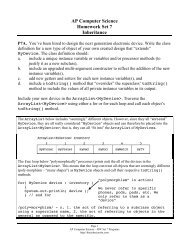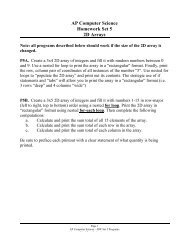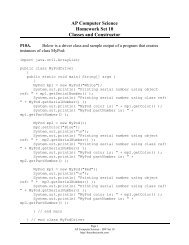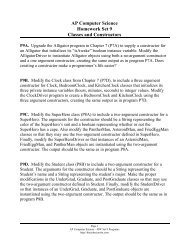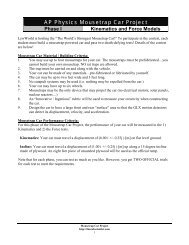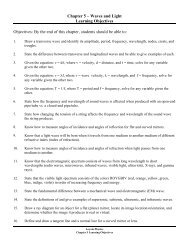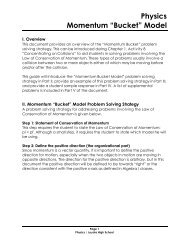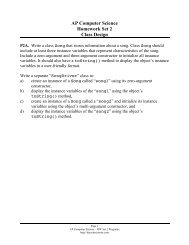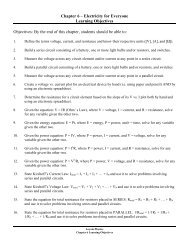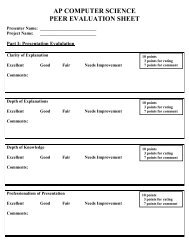AP Computer Science Homework Set 11 Exceptions
AP Computer Science Homework Set 11 Exceptions
AP Computer Science Homework Set 11 Exceptions
- No tags were found...
Create successful ePaper yourself
Turn your PDF publications into a flip-book with our unique Google optimized e-Paper software.
<strong>AP</strong> <strong>Computer</strong> <strong>Science</strong><strong>Homework</strong> <strong>Set</strong> <strong>11</strong><strong>Exceptions</strong>1. What type(s) of Exception(s) does the Java compiler ignore at compiletimeand why does it ignore them? What is special about these type of<strong>Exceptions</strong> that they are not (and usually cannot) be caught at compile-time?Answer:2. Creating an entire class for possible “programming errors” or“<strong>Exceptions</strong>” seems like overkill. What is the advantage to representing“program errors” as object of type Exception?Answer:3. What type of code is typically placed in each part of a “try - catch” block?Answer:Page 1<strong>AP</strong> <strong>Computer</strong> <strong>Science</strong> – Unit <strong>11</strong> Programshttp://thecubscientist.com
4. In class Chef below, method cookIngredients() makes a call to method“mixIngredients“ that throws a MixingException. Modify the cookIngredients()method call the mixIngredients() method using a try-catch block. If aMixingException exception is thrown, print the statement:“MixingException occurred”public class Chef{public void cookIngredients(){mixIngredients(); // throws MixingException}} // end class ChefAnswer:Page 2<strong>AP</strong> <strong>Computer</strong> <strong>Science</strong> – Unit <strong>11</strong> Programshttp://thecubscientist.com
5. The method cookIngredients() does not necessarily need to call themixIngredients() method using a try-catch block. It may instead “duck” theexception. Modify class Chef to “duck” the MixingException (forcing the codethat calls the cookIngredients() method to deal with the MixingException).Answer:6. Examine the ChefDriver class below:public class ChefDriver{public static void main(String[] args){Chef emeril = new Chef();emeril.cookIngredients();}}If the method cookIngredients() throws the exception MixingException (as in thequestion above), what will happen when the code “emeril.cookIngredients()” isexecuted?Answer:Page 3<strong>AP</strong> <strong>Computer</strong> <strong>Science</strong> – Unit <strong>11</strong> Programshttp://thecubscientist.com
7. The Throwable class defines two important methods, getMessage() andprintStackTrace(). Which of the following classes inherit these methods:IOException, InterruptedException, RunTimeException?Answer:8. Search the Java <strong>AP</strong>I the NullPointerException class. List threecircumstances under which this exception be thrown. Give a Java code examplethat would throw this exception under each of these circumstances.Answer:9. Search the Java <strong>AP</strong>I the ClassCastException class. Under whatcircumstance will this exception be thrown? Give a Java code example thatwould throw this exception.Answer:Page 4<strong>AP</strong> <strong>Computer</strong> <strong>Science</strong> – Unit <strong>11</strong> Programshttp://thecubscientist.com
10. Which of the following do you think are also RunTime<strong>Exceptions</strong>?Reference the Java <strong>AP</strong>I to check which of the following exceptions areRunTime<strong>Exceptions</strong>.a. IndexOutOfBoundsExceptionb. NoSuchMethodExceptionc. NegativeArraySizeExceptiond. StringIndexOutOfBoundExceptione. IllegalAccessExceptionAnswer:Page 5<strong>AP</strong> <strong>Computer</strong> <strong>Science</strong> – Unit <strong>11</strong> Programshttp://thecubscientist.com
12. The try-catch block looks like an if-else statement. Why aren’t if-elsestatements simply used to call methods that can throw exceptions? What do trycatchblocks offer that if-else statements do not?Answer:13. Why must you order catch blocks from smallest to largest? Specificallyaddress the problem that you would encounter if you ordered exceptions fromlargest to smallest. Use the inheritance tree on page 332 to give an example ofpossible problem. (note: the compiler will complain even if you attempt to dothis; this is just an exercise to see WHY the compiler complains).Answer:Page 7<strong>AP</strong> <strong>Computer</strong> <strong>Science</strong> – Unit <strong>11</strong> Programshttp://thecubscientist.com
14. Refer to the Exception class hierarchy on page 332. Which of the followingcatch blocks is in the INCORRECT location?try{laundry.doLaundry();}catch(UniformException uniformEx){}catch(TeeShirtException tshirtEx){}catch(ShirtException shirtEx){}catch(ClothingException clothingEx){}catch(LingerieException lingerieEx){}Answer:Page 8<strong>AP</strong> <strong>Computer</strong> <strong>Science</strong> – Unit <strong>11</strong> Programshttp://thecubscientist.com
15. Consider the following Exception class hierarchy.CoffeeExceptionCaffeinatedExceptionDecafExceptionLightExceptionDarkExceptionColumbian<strong>Exceptions</strong>HawaiianExceptionGiven the following try block and the CoffeeException hierarchy above,try{CoffeeDrinker.drinkCoffee(); //throws CoffeeException}Write all of the catch blocks needed to catch each of the exceptions in thehierarchy. Be sure to follow the “smallest to largest” rule for exceptions.Answer:Page 9<strong>AP</strong> <strong>Computer</strong> <strong>Science</strong> – Unit <strong>11</strong> Programshttp://thecubscientist.com




